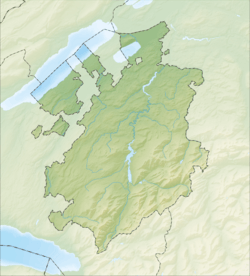Épendes, Fribourg facts for kids
Quick facts for kids
Épendes
|
||
|---|---|---|
|
||
| Country | Switzerland | |
| Canton | Fribourg | |
| District | Sarine | |
| Area | ||
| • Total | 5.63 km2 (2.17 sq mi) | |
| Elevation | 750 m (2,460 ft) | |
| Population
(December 2019)
|
||
| • Total | 1,085 | |
| • Density | 192.72/km2 (499.1/sq mi) | |
| Postal code |
1731
|
|
| Localities | Le Petit-Épendes, Sales | |
| Surrounded by | Arconciel, Ferpicloz, Le Mouret, Marly, Senèdes, Villarsel-sur-Marly | |
Épendes was once a municipality in the canton of Fribourg, Switzerland. It was located in the Sarine district. Its old German name was Spinz.
In 1977, the nearby village of Sales joined Épendes. Later, on January 1, 2021, Épendes merged with Arconciel and Senèdes to form a new municipality called Bois-d'Amont. A cool fact: an asteroid named 129342 Ependes was named in its honor!
Contents
History of Épendes
Épendes is quite old! It was first mentioned in historical records way back in 1142. At that time, it was known as Spindes.
What is the Geography of Épendes?
Épendes covered an area of about 5.6 square kilometers (about 2.2 square miles). A large part of this land, around 66%, was used for farming. About 24% was covered by forests, and the remaining 10% had buildings and roads.
Most of the built-up areas were homes and other buildings. The forested land was mainly dense forests. For farming, people grew crops on about 40% of the land, and the rest was used for pastures where animals could graze.
The former municipality included the main village of Épendes. It also had a small hamlet called Le Petit-Épendes. Since 1977, the village of Sales was also part of Épendes.
What is the Épendes Coat of Arms?
A coat of arms is like a special symbol for a town or family. The coat of arms for Épendes has a blue background. At the top, there's a gold band with a blue cross. Overlapping this, there's a silver lance with a red flag.
Population and Demographics
In 2019, Épendes had a population of 1,085 people. About 8.5% of the people living there were from other countries. Over ten years (from 2000 to 2010), the population grew by about 3.4%.
Most people in Épendes speak French as their main language (around 88%). German is the second most common language (about 9%), followed by Portuguese.
In 2008, the population was almost equally split between males (50.6%) and females (49.4%). About a third of the people living in Épendes in 2000 were also born there. Many others were born in the same canton (Fribourg).
Young people (ages 0–19) made up about 30% of the population in 2000. Adults (20–64 years old) were the largest group, at about 62%. Seniors (over 64) made up about 7%.
There were 354 private homes in Épendes in 2000, with an average of almost 3 people per home. Most of the apartments (over 94%) were lived in all year round.
The chart below shows how the population of Épendes has changed over time:

Economy and Jobs
In 2010, the unemployment rate in Épendes was low, at 1.5%. Many people living in Épendes worked in different types of jobs.
- Primary Sector: This includes jobs like farming and forestry. In 2008, about 46 people worked in this sector.
- Secondary Sector: This involves manufacturing (making things) and construction. About 51 people worked in this sector.
- Tertiary Sector: This covers services, like sales, transportation, education, and healthcare. About 80 people worked in this sector.
Most people who lived in Épendes traveled to other places for work. About 73% of workers used a private car to get to their jobs.
Religion in Épendes
According to the 2000 census, most people in Épendes were Roman Catholic (about 84%). A smaller group (around 6%) belonged to the Swiss Reformed Church. Some people belonged to other Christian churches, or were Islamic. About 5% of the population said they didn't belong to any church.
Education System
In Épendes, a good number of people have finished their education. About 34% of the population completed upper secondary education (like high school). Around 14% went on to higher education, either at a university or a specialized college.
The school system in Fribourg canton works like this:
- Kids start with one year of non-mandatory Kindergarten.
- Then, they go to six years of Primary school.
- After that, there are three years of lower Secondary school. Students are grouped based on their skills.
- Next, students can choose to go to an optional three or four-year upper Secondary school. This can be a gymnasium (which prepares them for university) or a vocational program (which teaches job skills).
- Finally, after upper Secondary, students can go to a Tertiary school or start an apprenticeship (learning a trade on the job).
During the 2010–11 school year, 153 students attended classes in Épendes. Many students from Épendes also went to schools in nearby towns for different levels of education.
See also
 In Spanish: Ependes (Friburgo) para niños
In Spanish: Ependes (Friburgo) para niños





